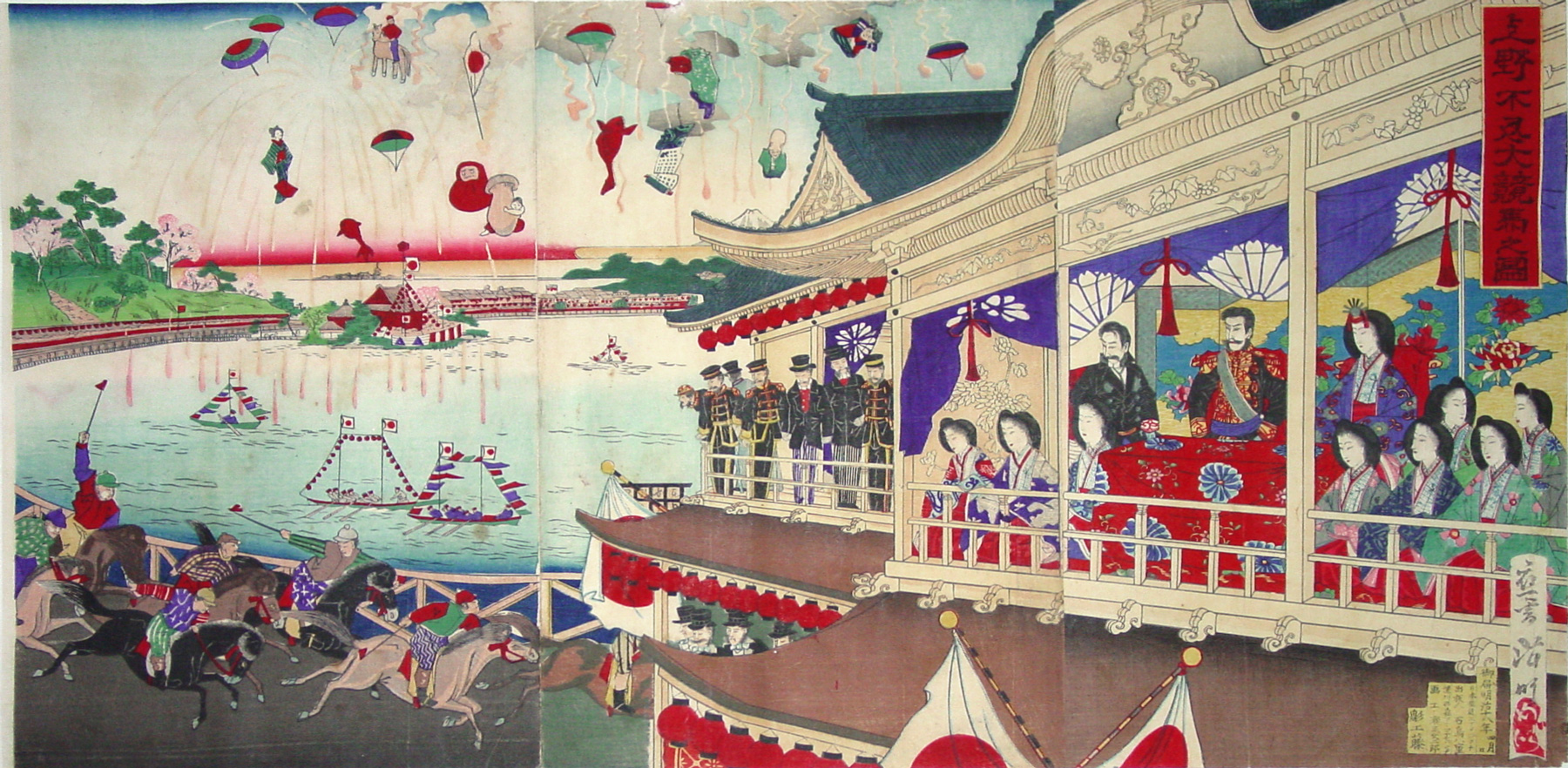About This Print
Source: Art Gallery of Greater Victoria website and Japan Awakens: Woodblock Prints of the Meiji Period (1868-1912), Barry Till, Pomegranate Communications, Inc., 2008, p. 35.The Meiji Emperor, Empress and their attendants are watching the horse racing at the new race track at Shinobazu Pond in Ueno Park. Festivities include fireworks and decorated boats on the pond.
Barry Till, Curator of Asian Art at the Art Gallery of Greater Victoria, in commenting on this print identifies the printmaker as an "unidentified artist, probably Hashimoto Chikanobu (1838-1912) and goes on to say, "Chikanobu made several versions of the imperial couple at European-style horse races; one, incorrectly, had the horses racing clockwise. This print is not signed by Chikanobu, but it is almost certainly his work." (See below images for some of Chikanobu's other prints of this scene.) However I have confirmed that the artist is not Chikanobu but Sekisai Kuniyasu (active 1880–1890s).
1 Nishikie ni miru meiji tenno to meiji jidai [The Meiji Emperor and the Meiji Period as Seen in Nishikie], Tsuneo Tanba, Asahi Shimbun Publishing Co., 1966, p. 71, pl. 99.
Horse Racing at Shinobazu Pond, Ueno
Source: National Diet Library website http://www.ndl.go.jp/scenery/e/column/ueno-park.html"Horse races were also held at the park in the Shinobazu Pond area. The inaugural race, held on November 1, 1884, was attended by Emperor Meiji. The following excerpt appeared in a Daily Yomiuri article dated
November 2, 1884:
| On the first day of the big horserace … great fireworks were set off 21 times … . Three decorated boats of the Navy Ministry made a circuit of the pond and then the first race was started. After each race was finished, fireworks were let off and music was played. Although it was a rainy day, many people came to see the horserace and the area was very crowded. A temporary bridge built over the pond was loaded with so many people that it almost fell into the pond. Also, Ueno hill was crowded with people hoping to catch a glimpse of the races. The last race finished at around 6:30 p.m. and then the Emperor departed." |
In describing an almost identical view of the races provided in Chikanobu's Picture of the Racetrack in Shinobazu in Ueno, 1885 (shown below), Julia Meech-Pekarik comments:
"The distant bleachers are crowded with high government officials recognizable then as now by their identical dark suits. There are festive sightseeing boats on the pond and Japanese fireworks (paper figures shot from bamboo cannons) materialize from puffs of smoke overhead. The emphasis, however, was on the artist's imaginary conception of the splendid royal box in the reviewing stand, crowded with the brilliant colors of the empress and her ladies. Their inclusion was often a matter of artistic license. The emperor still felt uncomfortable with the modern notion of appearing together with his wife in public, and they usually attended such functions on successive days."
Source: Wikipedia http://en.wikipedia.org/wiki/Shinobazu_Pond
"The pond's shape until the beginning of the Meiji Era was very different from now, in particular the northern part where the Ueno Zoo is, which was much wider. At the time, the Aizomegawa flowed into it. In 1884 however, a cooperative horse racing company, wanting to open a racing track, had the pond partly filled, bringing it to the present shape and size. The first horse race took place in the November of the same year in the presence of the Emperor, and until 1892 races took place every spring and summer."
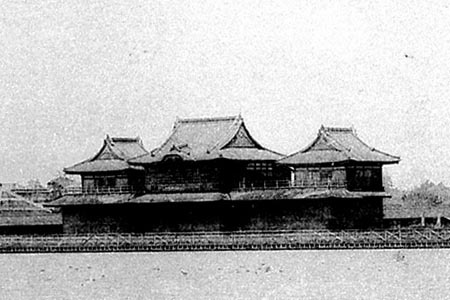 Undated photo Stands at Ueno Park horse racing track |  Undated photo The horse race track was built at Ueno Park in 1884 by filling in the area surrounding Shinobazu Pond. The left side of the fence next to the cherry trees is a one mile stretch. Horse racing was conducted not for gambling but for sheer entertainment. It is said that the Emperor's Cup started at this race track. The torii gate visible in the centre is part of Toshogu Shrine. Source: Nagasaki University Library Metadata Database of Japanese Old Photographs in Bakamatsu-Meiji Period http://oldphoto.lb.nagasaki-u.ac.jp/en/target.php?id=2666 |
A Favorite Subject
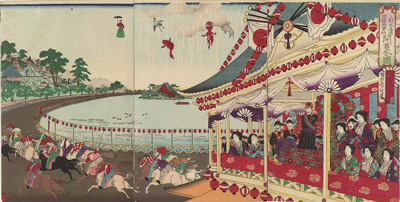 Union Horse Racing Club's Racetrack, 1884 | 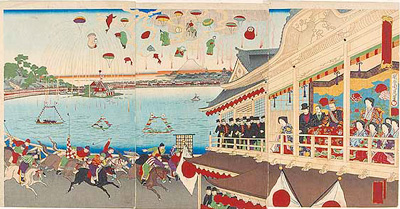 |
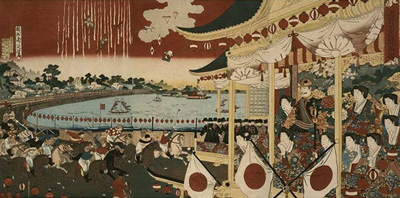 | 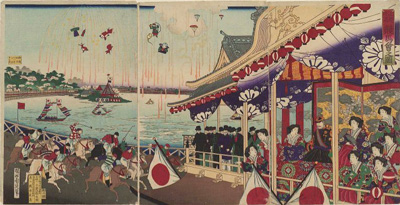 |
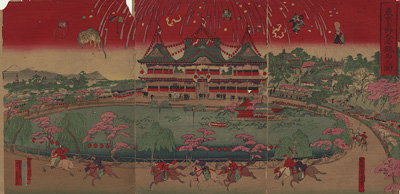 | 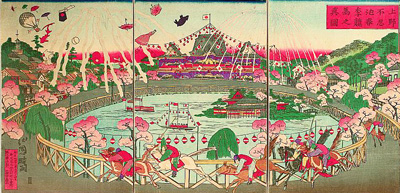 |
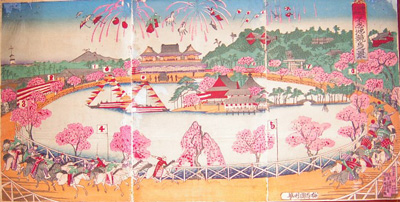 Kunitoshi, Horse Racing at Shinobazu Pond | 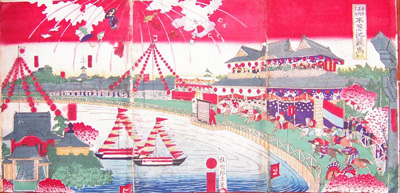 |
PowerPoint Presentation Notes from 1-31-2017 Presentation
Illustration of Horse Racing at Shinobazu Ueno, 1885 Atleast ten publishers released prints portraying this royal day at the races,all mixing reality with a bit of artisticlicense. While this print shows theemperor and empress sitting in the royal box, JuliaMeech,Japanese art historian and curator, pointsout that as the emperorwas uncomfortablewith the modern notion of appearing together with his wife in public, theemperor and empress usually attended such functions onsuccessive days. I might also point outthat while the DailyYomiuri tells us it was a rainy day at the races during the emperor’s visit,there was never a cloud in the sky in any print bearing a depiction of theemperor.The Daily Yomiuri recounts: On the first day of the big horse race … great fireworks were set off 21 times …. Three decorated boats of the Navy Ministry made a circuit of the pond and then the first race was started. After each race was finished, fireworks were let off and music was played. Although it was a rainy day, many people came to see the horse race and the area was very crowded. A temporary bridge built over the pond was loaded with so many people that it almost fell into the pond. Also, Ueno hill was crowded with people hoping to catch a glimpse of the races. The last race finished at around 6:30 p.m. and then the Emperor departed.
Print Details
| IHL Catalog | #473 |
| Title or Description | Illustration of Horse Racing at Shinobazu Ueno (Ueno Shinobazu Daikyoba no zu 上野不忍大競馬之図) |
| Artist | Sekisai Kuniyasu (active 1880–1890s) |
| Signature |  應需 治明 (ōju Haruaki) 應需 治明 (ōju Haruaki) |
| Seal | unread seal beneath artist's signature as shown above |
| Publication Date |  御届明治二八年四月 日 notification delivered April 1885 |
| Publisher |  right half of cartouche: 日本橋通三丁目一番地 Nihonbashidōri 3 chōme 1 banchi 出抜人 石島八重 publisher: Ishijima Yae left half of cartouche: 深川区西森下町一丁目四七番地 Fukagawa Nishimori Shitamachi 47 banchi 画工 瀬尾文ニ郎 artist: Seo Fumijirō |
| Carver |  |
| Impression | excellent |
| Colors | excellent |
| Condition | fair – margins trimmed; three sheets attached; minor backing remnants verso; thinning and several repairs along margin edges; minor soiling |
| Genre | ukiyo-e; kaika-e |
| Miscellaneous | |
| Format | vertical oban triptych |
| H x W Paper | 13 3/4 x 28 in. (34.9 x 71.1 cm) |
| Literature | Nishikie ni miru meiji tenno to meiji jidai [The Meiji Emperor and the Meiji Period as Seen in Nishikie], Tsuneo Tanba, Asahi Shimbun Publishing Co., 1966, p. 71, pl. 99; Japan Awakens: Woodblock Prints of the Meiji Period (1868-1912), Barry Till, Pomegranate Communications, Inc., 2008, p. 35. |
| Collections This Print | Art Gallery of Greater Victoria 2007.013.002 a-c; Waseda University Library 10 08616 0016; Henry Art Gallery, University of Washington FA 85.40 A |
3/7/2020


